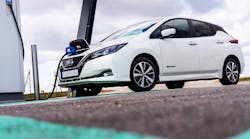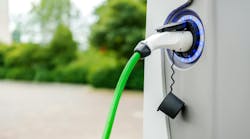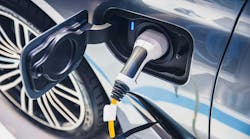Global electric vehicle sales are on the rise. In 2020 alone, electric vehicle (EV) sales rose 43% even as overall car sales slumped. According to consulting firm AlixPartners, EVs could represent about 24% of total car sales by 2030 — up from the 2% of sales today. In fact, an IBM consumer survey found 50% of consumers in five major metro cities currently own or lease an EV or plan to within the next few years.
This growing trend will put new demand strains on the grid. According to an Electric Vehicles as Distributed Energy Resources report by Rocky Mountain Institute, a 30-kWh EV battery stores as much electricity as the average U.S. residence consumes in a single day. Too much simultaneous charging in one area poses a major threat to grid stability — especially since EVs will charge in more locations than just the home garage — creating a new, unpredictable surge to accommodate.
The unpredictable nature of EV charging demand comes just as utilities are evolving how they balance and settle the grid. In the past, meeting peak demand meant tapping into peaker plants. These facilities typically are carbon intensive, costly to build and operate, and drive up the cost of power. Today, nearly 20% of grid power is generated through wind and solar, according to the U.S. Energy Information Administration. Moving forward, the collective goal of individuals, companies and industries should be to continue to increase that source in the energy mix.
The challenge is renewables such as wind and solar are weather dependent and, therefore, less predictable. Fossil fuels should not be leaned on as a crutch anymore. Instead, the solution is that utilities must operate as flexible orchestration platforms and ecosystem enablers.
Orchestration Platforms
Operating as an orchestration platform means utilities must evolve from a forecast-schedule-dispatch model into a real-time orchestrator of capabilities and ecosystems: Utilities need to bring together a network of resources and ecosystem partners to balance grid through decentralized, flexible units such as EVs.
That is right: Meeting the demand of EVs also means using them as a distributed energy resource (DER) and part of the solution.
Based on Harvard University engineering data published in the Environmental Impact Letters, for the U.S. to reach 100% of its electricity through solar and wind power projects, it could require one-third of the country to be covered by solar and wind facilities. There is no desire nor is it feasible to allocate that much land to solar and wind farms. Instead, utilities must modernize the grid to support bidirectionality and tie into ecosystems and marketplaces to unite residential and commercial solar panels, EVs and other DERs
This may sound quite complex, but it becomes feasible by taking a hybrid cloud approach to unite and manage these various resources and ecosystems on a common platform. A hybrid cloud approach means these disparate resources can run and operate on a variety of clouds or on premises yet are united to work together using an orchestration platform. By gaining visibility into the entire ecosystem, utilities can forecast, aggregate, optimize and settle across resources, thereby helping to accelerate achieving carbon reduction goals.
Platform Approach in Action
To meet the EU’s sustainable energy targets, at least half of electricity needs to come from renewable sources by 2030, compared to 32% in 2018. To achieve this, TenneT, a leading European grid operator, worked with IBM to create a blockchain-based platform that would allow it to tie into other clean energy providers in the market, such as Vandebron Energie BV and the sonnenCommunity.
Both Vandebron and sonnen could be viewed as competitors of TenneT, as they offer clean energy options directly to customers. Vandebron offers its approximately 100,000 customers access to 100% renewable energy sourced from a network of more than 120 local, small suppliers, such as excess supply from EVs. On the other hand, sonnen GmbH manufactures and distributes home battery and energy-storage systems. The sonnen batteries store energy generated by home solar panels.
Typically, homeowners use the stored energy from these batteries to power their homes or sell the energy back to the electricity distributor when rates are highest.
Rather than compete, TenneT worked with IBM to develop a platform that harnesses the strengths of these power providers together to accelerate the volume of renewable energy available to meet demand. During peak demand on the grid, TenneT can tap into its network to balance the grid or discharge excess to reduce transmission bottlenecks in the grid. The result is a win-win-win: TenneT can balance the grid and ensure power, and Vandebron and sonnen customers can monetize their energy assets when not in use. In addition, this platform approach helps to maximize the amount of wind and solar energy available to meet power demand — a step in the right direction toward achieving EU sustainable energy targets.
Building on the success of this platform, TenneT partnered with other European transmission grid operators, including Terna (Italy), Swissgrid (Switzerland) and APG (Austria) to form Equigy, a European crowd balancing platform. Together, these four grid operators and a network of energy players help to meet demand with a higher percentage of clean-energy resources while reducing the reliance on fossil fuels during peak demand. In addition, because this approach is connecting existing assets, existing customer bases and existing back-end systems, the upfront costs are low.
More Players Involved
Interest is brewing on the part of EV manufacturers and automakers to allow their customers to opt in directly to reduce the total cost of EV ownership. Equigy and TenneT are working with BMW Group to interlink vehicles, charging infrastructure and power grids to maximize the use of renewable energy for EV charging.
City leaders also are getting involved. For example, IBM is working with the City of Copenhagen to deploy the IBM Utilities Flex Platform, which also integrates building assets. When the grid needs balancing as a result of fluctuating renewables or demand peaks, the platform’s artificial intelligence analyzes when connected assets — like heating, ventilation and air-conditioning (HVAC) systems, water pumps and data centers — can be optimized with little impact on their performance. The platform orchestrates their energy requirements, in effect providing flexibility to the grid in lieu of relying on reserve power plants.
Up Next
The shift to the utility-as-an-orchestration platform model sets the foundation for future technologies to further optimize the rapidly decentralized infrastructure. In September 2021, E.ON SE announced its plans to work with IBM Quantum to do just that.
Quantum computing is a new type of computing that harnesses the phenomena of quantum mechanics, which could deliver a huge leap forward in certain problems are solved. While classical systems are not going away, quantum computing can solve complex problems — those that are fundamentally too complex for classical computers to solve — exploiting a multidimensional parameter space that can yield exponential outcomes.
For example, as part of E.ON’s Vehicle to Grid (V2G) project, batteries from EVs are connected to the distribution grid as a flexible storage medium. In this way, fluctuations in the generation of renewable energy can be balanced. The coordination and control of the system require enormous computing power, of which current classical computing systems are not capable. A quantum computer has the potential to perform these necessary calculations in completely different ways that could be done in a shorter time frame. This kind of innovative technology is key to advance the energy transition. However, it can only be realized through the critical foundation of utilities evolving to operate as orchestration platforms.
Mahesh Sudhakaran is the general manager for IBM’s Energy, Environment, and Utilities Industry. In this role, he leads a global team focused on sales, strategy, product management, and partnerships for the industry. His mission is to support energy and utility companies globally lead in the era of sustainable energy transition with clean electrification. Sudhakaran has a BS in electrical and electronics engineering, First Class with Distinction, from the National Institute of Technology, India, and an MBA, Director’s List, from the University of Cambridge.
For More Information
BMW | www.bmwgroup.com
E.ON | www.eon.com
Equigy | https://equigy.com
sonnen | https://sonnengroup.com
TenneT | www.tennet.eu
Vandebron | https://vandebron.nl


